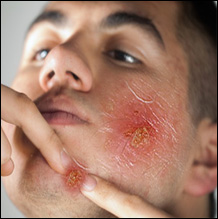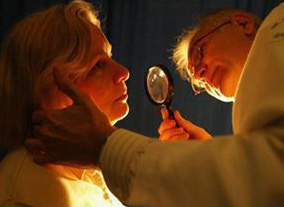 |
 |
| |
|
 |
| |
Skin Tumours & Cancers: |
|
| |
| |
| Skin Cancer Overview:
Skin cancer is the most common of all human cancers. Some form of skin cancer is diagnosed in more than 1 million people in the United States each year.

Cancer occurs when normal cells undergo a transformation during which they grow and multiply without normal controls.
- As the cells multiply, they form a mass called a tumor. Tumors of the skin are often referred to as lesions.
- Tumors are cancerous only if they are malignant. This means that they encroach on and invade neighboring tissues because of their uncontrolled growth.
- Tumors may also travel to remote organs via the bloodstream or lymphatic system.
- This process of invading and spreading to other organs is called metastasis.
- Tumors overwhelm surrounding tissues by invading their space and taking the oxygen and nutrients they need to survive and function.
- Skin cancers are of three major types: basal cell carcinoma (BCC), squamous cell carcinoma (SCC), and melanoma.
- The vast majority of skin cancers are BCCs or SCCs. While malignant, these are unlikely to spread to other parts of the body. They may be locally disfiguring if not treated early.
- A small but significant number of skin cancers are malignant melanomas.Malignant melanoma is a highly aggressive cancer that tends to spread to other parts of the body. These cancers may be fatal if not treated early.
- Like many cancers, skin cancers start as precancerous lesions. These precancerous lesions are changes in skin that are not cancer but could become cancer over time. Medical professionals often refer to these changes as dysplasia. Some specific dysplastic changes that occur in skin are as follows:
- Actinic keratosis is a patch of red or brown, scaly, rough skin, which can develop into squamous cell carcinoma.
- A nevus is a mole, and dysplastic nevi are abnormal moles. These can develop into melanoma over time.
- Moles (nevi) are simply growths on the skin. They are very common. Very few moles become cancer.
- Most people have 10-40 moles on their body.
- Moles can be flat or raised; some begin as flat and become raised over time.
- The surface is usually smooth.
- Moles are round or oval and no larger than ¼-inch across.
- Moles are usually pink, tan, brown, or the same color as the skin. Other colors are sometimes noted.
- An individual's moles usually look pretty much alike. A mole that looks different from the others should be examined by your health-care provider.
- Dysplastic nevi are not cancer, but they can become cancer.
- People with dysplastic nevi often have a lot of them, perhaps as many as 100 or more.
- People with many dysplastic nevi are more likely to develop melanoma, either within an existing nevus or on an area of normal skin.
- Dysplastic nevi are usually irregular in shape, with notched or fading borders.
- Dysplastic nevi may be flat or raised, and the surface may be smooth or rough ("pebbly").
- Dysplastic nevi are often large, ¼-inch across or even larger.
- Dysplastic nevi are typically of mixed color, including pink, red, tan, and brown.
Recent studies demonstrate that the number of skin cancer cases in the United States is growing at an alarming rate. Fortunately, increased awareness on the part of Americans and their health-care providers has resulted in earlier diagnosis and improved outcomes. |
| |
| |
| Causes:
ltraviolet (UV) light exposure, most commonly from sunlight, is overwhelmingly the most frequent cause of skin cancer.
 Other important causes of skin cancer include the following: Other important causes of skin cancer include the following:
- Use of tanning booths
- Immunosuppression-impairment of the immune system, which protects the body from foreign entities, such as germs or substances that cause an allergic reaction. This may occur as a consequence of some diseases or can be due to medications prescribed to combat autoimmune diseases or prevent organ transplant rejection.
- Exposure to unusually high levels of x-rays
- Contact with certain chemicals-arsenic(miners, sheep shearers, and farmers), hydrocarbons in tar, oils, and soot (may cause squamous cell carcinoma)
The following people are at the greatest risk:
- People with fair skin, especially types thatfreckle, sunburn easily, or become painful in the sun
- People with light (blond or red) hair and blue or green eyes
- Those with certain genetic disorders that deplete skin pigment such as albinism,xeroderma pigmentosum
- People who have already been treated for skin cancer
- People with numerous moles, unusual moles, or large moles that were present at birth
- People with close family members who have developed skin cancer
- People who had at least one severe sunburn early in life
Basal cell carcinomas and squamous cell carcinomas are more common in older people. Melanomas are more common in younger people. For example, melanoma is the most common cancer in people 25-29 years of age. |
| |
| |
| Symptoms: |
| |
A basal cell carcinoma (BCC) usually looks like a raised, smooth, pearly bump on the sun-exposed skin of the head, neck, or shoulders.
- Small blood vessels may be visible within the tumor.
- A central depression with crusting and bleeding (ulceration) frequently develops.
- A BCC is often mistaken for a sore that does not heal.
- A squamous cell carcinoma (SCC) is commonly a well-defined, red, scaling, thickened patch on sun-exposed skin.
- Like BCCs, SCCs may ulcerate and bleed.
- Left untreated, SCC may develop into a large mass.
- The majority of malignant melanomas are brown to black
 pigmented lesions. pigmented lesions.
- Warning signs include change in size, shape, color, or elevation of a mole.
- The appearance of a new mole during adulthood, or new pain, itching, ulceration, or bleeding of an existing mole should all be checked by a health-care provider.
- The following easy-to-remember guideline, "ABCD," is useful for identifying malignant melanoma:
- Asymmetry-One side of the lesion does not look like the other.
- Border irregularity-Margins may be notched or irregular.
- Color-Melanomas are often a mixture of black, tan, brown, blue, red, or white.
- Diameter-Cancerous lesions are usually larger than 6 mm across (about the size of a pencil eraser), but any change in size may be significant.
|
| |
| |
| |
| ---------------------------------------------------------------------------------------------------------------------------------------- |
| |
| Skin Tumors: |
| |
 Skin tumors are skin problems that sometimes cause pain. Skin cysts are non-cancerous closed pockets or pouches of tissue that are filled with fluid or other material. They feel like small peas beneath the surface of the skin and usually feel smooth and roll under the skin when pressure is applied to them. Skin tumors are skin problems that sometimes cause pain. Skin cysts are non-cancerous closed pockets or pouches of tissue that are filled with fluid or other material. They feel like small peas beneath the surface of the skin and usually feel smooth and roll under the skin when pressure is applied to them.
Skin tumors are abnormal growths of tissue that can be malignant (cancerous) or benign (harmless). Skin tumors become extremely common as people get older.
Some common benign tumors include:
- Warts (skin tumor resulting from a virus)
- Seborrheic keratoses (growths on the skin ranging from light skin color to dark brown)
- Nevi (skin growths such as moles or birthmarks)
What Causes Skin Tumors?
The cause of skin tumors is not known, but some people may be likely to develop more or less of them based on heredity.
How Are Skin Tumors Treated?
Often, no treatment is required for skin tumors. However, methods to treat skin tumors may include:
- Curettage and electrodesiccation: This involves scraping away the tumor tissues with a sharp surgical instrument called a curette. An electrosurgical unit may then be used to stop bleeding.
- Surgical excision: This involves cutting into the skin, removing the growth, and closing the wound with stitches.
- Cryosurgery: During this procedure, liquid nitrogen is sprayed directly onto the skin or an instrument is used to freeze the tissue.
Pain is alleviated once the cyst or tumor is removed. For short-term pain resulting from treatment, Tylenol or Aleve may be taken. |
| |
| |
| |
|
|
|
 |
|

